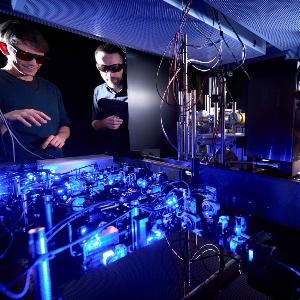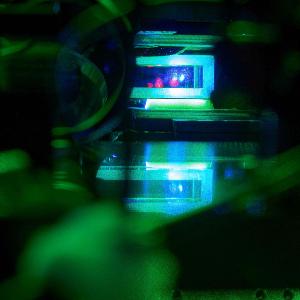Quantum simulation: making collective phenomena visible
21 Nov 2025
Researchers at LMU and the MCQST Cluster of Excellence are developing methods for the direct observation of novel many-body systems.
21 Nov 2025
Researchers at LMU and the MCQST Cluster of Excellence are developing methods for the direct observation of novel many-body systems.

LMU physicist Johannes Zeiher (left) in the laboratory. | © MQV / Jan Greune
In the world of quantum physics, many particles collectively often behave quite differently than would be expected from the properties of the individual units. The properties of these quantum many-body systems are strongly dependent on the range of the interactions between the particles. When such interactions occur not only between immediate neighbors, but extend over multiple sites, this can give rise to unusual collective phenomena or exotic states of matter – such as systems with special structures or bonded pairs of particles that should actually repel each other.
In their new paper, which was recently published in the journal Science, a team led by LMU physicists Johannes Zeiher, Immanuel Bloch, and Annabelle Bohrdt, all members of the MCQST Cluster of Excellence, employ an experimental method to manipulate novel many-body systems. Known as Rydberg dressing, this technique from the quantum optical toolbox involves “admixing” very strongly interacting states to otherwise rather weakly interacting atoms with laser light. This allows scientists to fine-tune the strength and range of the forces between atoms very precisely – across multiple lattice spacings. In their quantum simulation experiment, the team manipulated rubidium atoms.

Cold atoms in a light trap. The researchers conducted their experiment in a setup like this. | © MQV / Jan Greune
Normally, it is difficult to investigate such long-range interactions in a system of moving atoms in a controlled manner. The team was able to solve this problem by means of a special stroboscopic illumination technique, which kept the system stable for long enough to directly observe the complex many-body effects under a quantum gas microscope.
“The method makes it possible to see completely new collective quantum effects which were previously more or less inaccessible to experiments,” says Johannes Zeiher. “Particularly interesting is the prospect of being able to control interactions through laser light.” The method thus allows scientists to specifically observe quantum states that have been theoretically predicted.
Conceivably, the method could also be used to simulate models which are relevant to phenomena in solid-state physics, such as superconductivity. Equally, it could facilitate the investigation of exotic materials – for example, materials that exhibit properties of fluids and solids at the same time, so-called supersolids. “If we can make further technical improvements, such as better cooling, or use other atomic species than rubidium, this would allow even more complex investigations,” says Zeiher.
Pascal Weckesser, Kritsana Srakaew,, Tizian Blatz, David Wei, Daniel Adler, Suchita Agrawal, Annabelle Bohrdt, Immanuel Bloch, Johannes Zeiher: Realization of a Rydberg-dressed extended Bose-Hubbard model. Science, 2025.